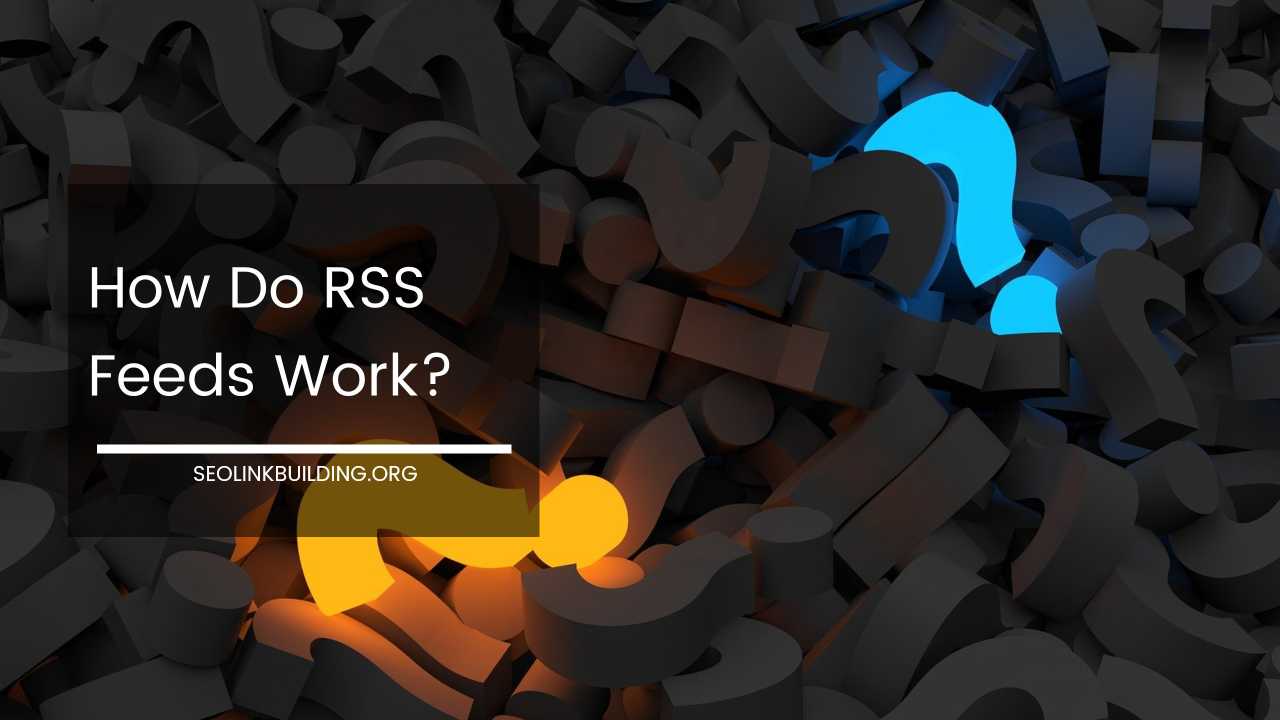How Do RSS Feeds Work?

How Do RSS Feeds Work? Stay Informed in a Streamlined Way
In today’s information age, staying abreast of the latest news, blog posts, and updates from your favorite websites can feel like navigating a firehose. Social media feeds overflow with irrelevant content and constant notifications, while manually checking every site you’re interested in is a time-consuming chore.
This is where RSS feeds come in as a knight in shining armor. RSS, standing for Really Simple Syndication, offers a streamlined way to follow content updates from various websites in a single, centralized location. But how exactly do these unsung heroes function?
Behind the Scenes: The Power of XML and the Anatomy of an RSS Feed
RSS feeds leverage a technology called Extensible Markup Language (XML). Imagine XML as a standardized language for computers to communicate and share information. An RSS feed is essentially a file containing details about a website’s latest content, formatted in this XML language.
Think of it like a digital newspaper delivery system, with the RSS feed acting as the newspaper itself. Here’s a breakdown of the key elements you’ll find within an RSS feed:
- Titles: Catchy headlines for each new piece of content, grabbing your attention and giving you a quick glimpse of what the article is about.
- Summaries: Brief descriptions of the content, allowing you to quickly grasp the main points without having to visit the full article yet. Think of it as a concise elevator pitch for the content.
- Links: The direct URLs to access the full content on the website. These links act as the gateway to the complete information.
- Publication Dates: Keeping you informed about when each piece of content was published. This is crucial for staying on top of breaking news or time-sensitive updates.
- Authors: Identifying who created the content. This allows you to follow specific writers you enjoy or trust as a source of reliable information.
- Categories: Tags that help categorize content for easier organization. Imagine categories as filing cabinets for your information, allowing you to sort and filter content based on subject matter.
The Role of the Aggregator: Bringing the Content Symphony Together
While the XML file stores the website’s content information, you don’t interact with it directly. This is where RSS feed readers, also known as aggregators, come into play.
These are software applications designed to collect and display information from various RSS feeds, acting as your personal news conductor.
Here’s how aggregators work, orchestrating the content flow:
- Subscription: You instruct your RSS reader to subscribe to the RSS feed of a website you’re interested in. Many websites display an RSS feed icon (often an orange box with white radio waves) or a link labeled “RSS” that you can click to subscribe. This is akin to placing an order for a specific newspaper subscription.
- Feed Checking: The RSS reader periodically checks the subscribed feeds for updates. The frequency of these checks can be customized, allowing you to control how often your reader searches for new content. Think of it as the reader going to the newsstand to see if there are any new issues of your subscribed publications.
- Content Aggregation: When the reader finds new content in a feed, it retrieves the relevant details (title, summary, link) and displays them in a user-friendly format. This is where the reader gathers the headlines and summaries from your subscribed feeds, presenting them in a way that’s easy for you to scan through.
- Organization: RSS readers typically organize the aggregated content chronologically, with the newest entries at the top. This allows you to quickly scan through headlines and summaries to see what’s new, similar to how a newspaper lays out its articles.
- Marking as Read: Once you’ve read a piece of content, you can mark it as read within the RSS reader. This helps you keep track of what you’ve already seen and avoid revisiting the same content. Imagine checking off articles you’ve read in a physical newspaper to avoid confusion.
Benefits of Using RSS Feeds: A Streamlined Path to Knowledge
Incorporating RSS feeds into your content consumption routine offers a multitude of advantages, streamlining your information gathering process:
- Efficiency is King: No more manually checking multiple websites, wasting precious time. RSS feeds bring all your updates together in one place, saving you valuable hours that can be better spent elsewhere.
- Focus on What Matters: By subscribing to specific feeds, you filter out irrelevant content and noise. This allows you to focus on the information that truly interests you, decluttering your information diet.
- Customization is Key: RSS readers allow you to prioritize feeds, categorize content based on subject matter, and personalize your reading experience to fit your preferences. Imagine customizing your newspaper by rearranging the sections and highlighting articles you’re most interested in.
- Real-time Updates Keep You Informed: RSS feed readers notify you as soon as new content is published, ensuring you stay on top of the latest developments in your chosen fields. This is like having a personal news alert system for the topics you care about.
- Offline Reading for On-the-Go Access: Many RSS readers allow you to download content for offline reading. This is perfect for situations when you don’t have an internet connection, such as during commutes or flights. It’s like having a portable library of articles you can access anytime, anywhere.
Finding the Perfect RSS Reader: A Matchmaker for Your Content Needs
With the growing popularity of RSS feeds in the early 2000s, numerous RSS reader applications emerged. While some web browsers offered built-in RSS functionality, dedicated reader applications provided a more comprehensive experience.
Today, the landscape of RSS readers has evolved. Many web browsers no longer offer native support for RSS feeds. However, a variety of standalone RSS reader applications are still available, catering to different user preferences. Here’s a curated list to help you find your perfect match:
- Feedly: A web-based reader with a clean interface and mobile app compatibility, making it accessible from any device. It offers a freemium model with basic features available for free and premium tiers with additional functionalities like advanced filtering and note-taking.
- Inoreader: Another web-based option with powerful filtering and organization features. It allows you to create custom filters to categorize content based on specific keywords or criteria. Inoreader also boasts a free tier with generous limitations and paid plans with increased storage and features.
- The Old Reader: A self-hosted reader for users who prefer more control over their data. This option requires some technical know-how to set up but offers complete privacy and customization. It’s ideal for users who value data ownership and a truly personalized experience.
- Newsblur: A reader known for its focus on privacy and customization. It offers a unique “blurring” feature that hides irrelevant content within articles, allowing you to focus on the main points. Newsblur operates on a subscription model, providing a premium, privacy-focused experience.
- Pocket: While not strictly an RSS reader, Pocket allows you to save articles and blog posts for later reading, offering a similar content organization benefit. It’s a great option for casual readers who want to accumulate interesting content for future consumption. Pocket functions on a freemium model with a free tier and a premium tier offering features like permanent offline storage and full-text search.
The Future of RSS Feeds: Still Relevant in the Age of Social Media
With the rise of social media platforms like Twitter and Facebook, some might question the continued relevance of RSS feeds. However, RSS feeds offer distinct advantages over social media for content consumption:
- Focus on Content, Not Noise: Social media feeds are often cluttered with irrelevant content, such as advertisements, personal updates, and clickbait articles. RSS feeds allow you to curate a personalized stream of content that aligns with your specific interests.
- Control Over Your Experience: With RSS feeds, you control the sources you follow and the frequency of updates. Social media algorithms often prioritize content based on engagement metrics, not necessarily what you find most valuable.
- Deeper Dives: RSS feeds typically provide summaries and links to full articles, allowing you to delve deeper into topics that pique your interest. Social media posts are often limited in character count and may not offer the same level of detail.
- Privacy Matters: Many social media platforms collect and analyze user data to target advertising. RSS feeds offer a more private way to consume content, without the constant feeling of being tracked.
Final Word: RSS Feeds – Your Gateway to a More Informed You
In today’s information overload, RSS feeds can be a powerful tool to stay informed and engaged with the topics you care about.
By leveraging their efficiency, focus, customization, and control over your content experience, RSS feeds can empower you to become a more informed and discerning information consumer. So, why not give them a try and see how they can streamline your information diet and enrich your knowledge journey?













